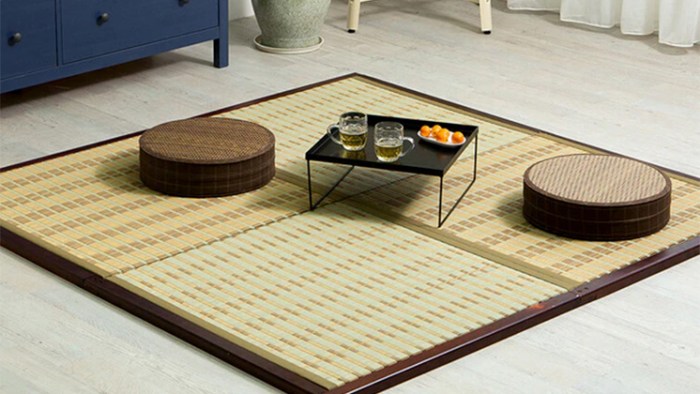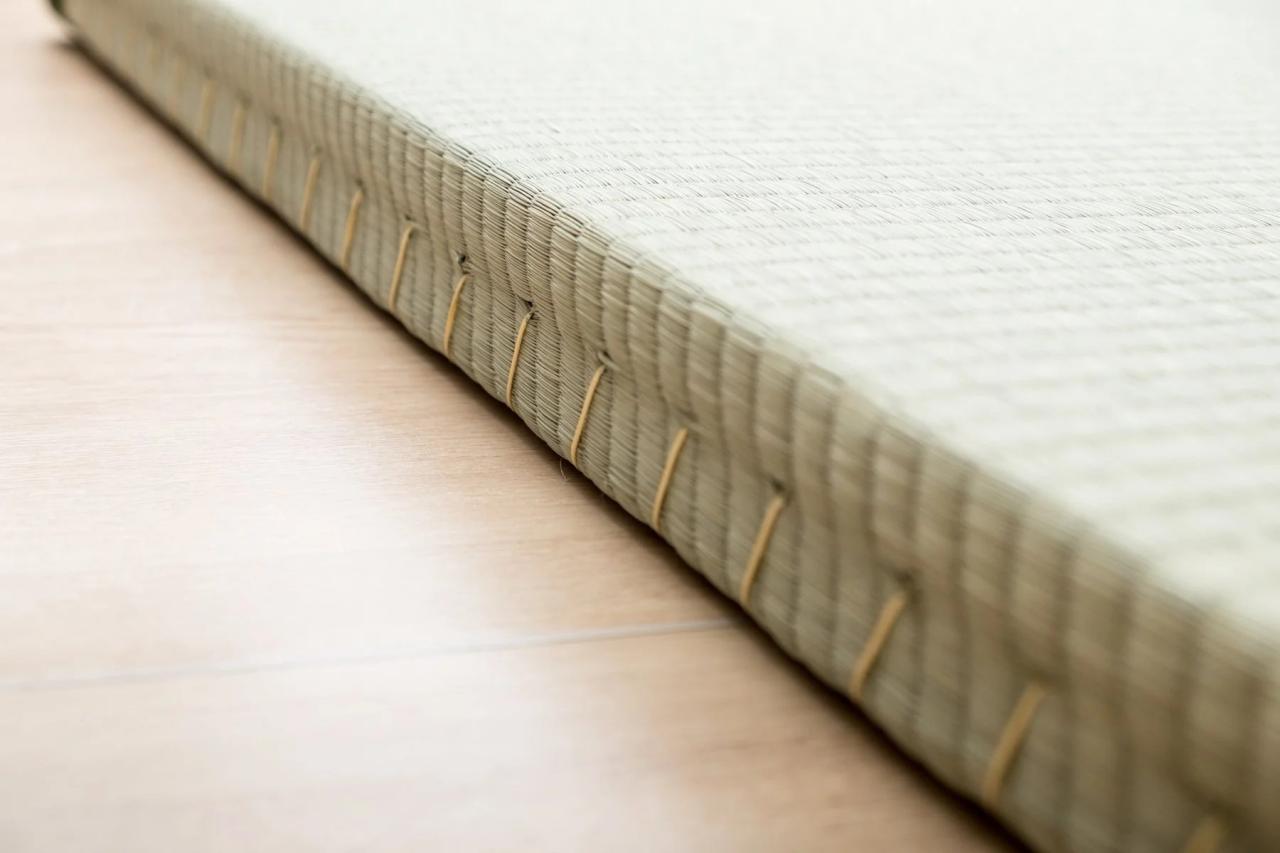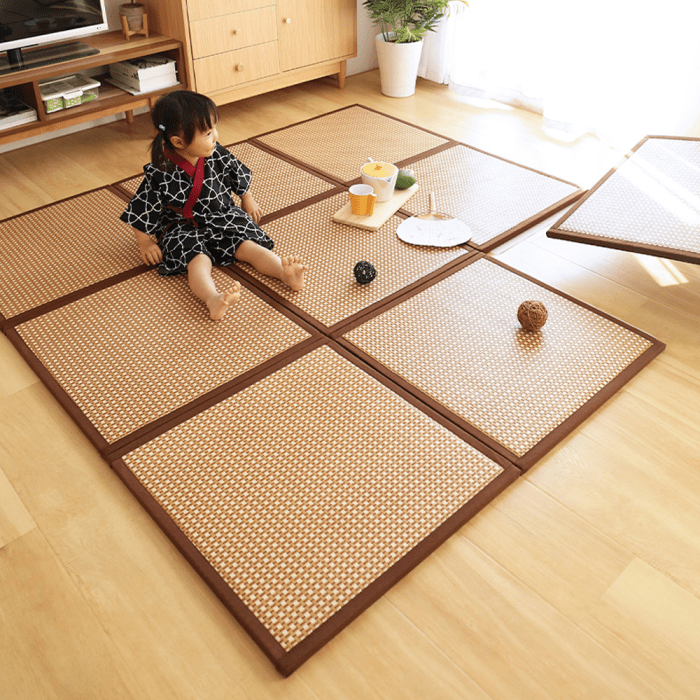Immerse yourself in the world of tatami mattresses, where comfort, health, and tradition intertwine. These versatile mats, steeped in Japanese heritage, offer a unique blend of functionality and aesthetics that can elevate any living space.
From their intricate construction to their myriad health benefits, tatami mattresses have captivated people for centuries. Join us as we explore the fascinating history, modern applications, and proper care of these remarkable sleep companions.
Materials and Construction: Tatami Mattress

Tatami mats are traditional Japanese flooring coverings that have been used for centuries. They are made from natural materials, primarily rice straw, and are known for their durability, comfort, and versatility.
Traditionally, tatami mats were made from a core of rice straw that was wrapped in a layer of woven rush grass. The rush grass was then stitched together with cotton thread to create a durable and flexible mat.
Modern Materials, Tatami mattress
In modern times, tatami mats are still made from rice straw, but they may also incorporate other materials, such as foam or synthetic fibers. These materials can provide additional comfort and durability, making tatami mats suitable for a wider range of applications.
Weaving and Stitching Techniques
The weaving and stitching techniques used to create tatami mats have remained largely unchanged for centuries. The rush grass is woven together in a herringbone pattern, which creates a strong and flexible mat. The mats are then stitched together with cotton thread, which helps to keep them in place and prevent them from fraying.
Tatami mattresses have been used in Japan for centuries and are still popular today. They are made from natural materials and are designed to be firm and supportive. While tatami mattresses are not as comfortable as bean bags , they are more durable and can last for many years.
Tatami mattresses are also easy to clean and maintain, making them a good choice for people who want a low-maintenance flooring option.
Comfort and Health Benefits
Tatami mats offer several ergonomic and health benefits that contribute to a comfortable and restful sleep experience.
The firm yet supportive surface of tatami mats provides optimal support for the body, promoting proper spinal alignment and reducing pressure points. Studies have shown that sleeping on tatami mats can improve posture and alleviate back pain, particularly in individuals with chronic lower back pain.
Moisture-wicking Properties
Tatami mats are highly moisture-wicking, which means they effectively absorb and release moisture. This helps regulate body temperature and creates a comfortable sleeping environment, even during hot and humid nights.
Cultural Significance and Tradition
Tatami, with its unique woven texture and earthy aroma, holds immense cultural significance in Japan, transcending its practical function as a flooring material. Its history is intertwined with the nation’s traditions, customs, and artistic expressions.
The tatami mattress is a traditional Japanese sleeping surface that has been used for centuries. It is made from natural materials, such as rice straw and jute, and is known for its durability and comfort. If you are looking for a way to add extra comfort to your tatami mattress, you may want to consider using a mattress topper . Mattress toppers are available in a variety of materials, including memory foam, latex, and down, and can help to provide additional support and cushioning.
This can make a big difference in the quality of your sleep, and can help you to wake up feeling refreshed and rejuvenated. In addition, mattress toppers can also help to protect your tatami mattress from wear and tear, extending its lifespan.
Traditional Uses in Homes and Temples
In traditional Japanese homes, tatami mats define living spaces, creating a harmonious and versatile environment. They serve as seating areas, sleeping surfaces, and even dining tables. In temples and shrines, tatami adds an air of solemnity and reverence, providing a sacred space for meditation and worship.
Martial Arts and Tea Ceremonies
Tatami plays a pivotal role in Japanese martial arts, such as judo and karate. Its firm yet yielding surface provides a safe and comfortable training ground. In tea ceremonies, tatami mats create an ambiance of tranquility and respect, enhancing the ritual’s meditative and social aspects.
Modern Applications and Design

In contemporary design, tatami mats transcend their traditional roots and embrace innovative aesthetics and functionality. They seamlessly integrate into modern home décor, adding a touch of natural elegance and versatility.
Beyond residential spaces, tatami mats find their niche in commercial applications, particularly in yoga studios and spas. Their inherent comfort and sound-absorbing properties create an ideal environment for mindful practices and relaxation.
Tatami mattresses, with their traditional Japanese origins, have long been a staple in homes and temples. Their unique woven texture and firm support make them an excellent choice for those who prefer sleeping on the floor. For more information on other sleeping mattress on floor options, visit here . Tatami mattresses offer a firm and supportive surface, providing a restful sleep experience that is both comfortable and rejuvenating.
Incorporation into Modern Home Décor
Tatami mats lend themselves beautifully to various interior styles. They can serve as flooring, wall coverings, or even furniture elements. Their natural texture and earthy tones complement both traditional and modern furnishings, creating a harmonious and inviting ambiance.
- Flooring:Tatami mats as flooring provide a soft and comfortable surface, perfect for cozy living rooms or serene bedrooms. Their sound-absorbing qualities enhance tranquility and privacy.
- Wall Coverings:Tatami mats on walls add a touch of organic warmth and texture. They can create feature walls or serve as a backdrop for artwork, creating a visually captivating space.
- Furniture:Tatami mats can be incorporated into furniture design, such as bed frames, headboards, and ottomans. Their natural materials and minimalist aesthetic add a touch of Japanese-inspired simplicity to any room.
Use in Commercial Spaces
The versatility of tatami mats extends to commercial spaces, where they offer unique benefits and create specific atmospheres.
- Yoga Studios:Tatami mats provide a comfortable and non-slip surface for yoga practice. Their natural materials promote a sense of connection to nature and enhance mindfulness.
- Spas:Tatami mats in spas create a relaxing and rejuvenating ambiance. Their soft texture and sound-absorbing properties contribute to a serene and tranquil environment.
Maintenance and Care
Tatami mats require regular cleaning and maintenance to ensure their longevity and hygiene. Proper care extends their lifespan, preserves their natural beauty, and prevents potential hazards associated with neglected mats.
Cleaning and Maintenance
- Regularly vacuum or sweep the mats to remove dust, dirt, and debris.
- For spills or stains, blot immediately with a clean, damp cloth. Avoid using harsh chemicals or detergents.
- If necessary, use a mild soap solution to clean the mats. Rinse thoroughly with water and allow them to dry completely.
Air and Rotation
Proper ventilation is crucial for tatami mats. Regular airing helps prevent moisture buildup, mold growth, and musty odors. Rotate the mats periodically to distribute wear evenly and prevent sagging.
Hazards and Concerns
Mold and mildew can grow on neglected tatami mats, posing health risks. Proper ventilation and cleaning prevent this issue. Additionally, avoid placing heavy objects on the mats for extended periods, as this can cause permanent indentations.
Epilogue

Whether you’re seeking a restful night’s sleep, a touch of Japanese tradition in your home, or a unique design element, tatami mattresses offer an exceptional combination of comfort, health, and timeless style. Embrace the beauty and benefits of these remarkable mats and experience the essence of Japanese living in your own space.
General Inquiries
What are tatami mattresses made of?
Tatami mattresses are traditionally crafted from woven rush grass (igusa) and rice straw, creating a durable and breathable surface.
How do tatami mattresses benefit my health?
Tatami mats provide excellent support for the spine, reducing back pain and improving posture. Their moisture-wicking properties create a comfortable sleep environment, promoting restful sleep.
How do I care for my tatami mattress?
Regular airing and rotation are essential for maintaining the lifespan of tatami mats. Avoid excessive moisture and use a soft brush to remove dust. Professional cleaning is recommended every few years.